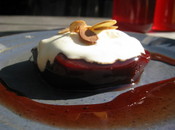Ayva tatlısı
Reaching Turkey last April, after two months of meandering through France, Germany, the Czech Republic, Poland, Hungary, Romania and Bulgaria to get there, was cause for celebration. So we scoured guide books to find a suitably smart restaurant in the old quarter of İstanbul, where we had just managed to navigate our chunky Land Rover through minuscule cobbled streets packed with pedestrians.
 Balıkçı Sabahattin, a fish restaurant frequented by wealthy locals, proved perfect. The fish börek, marinated bass and scorpion fish soup were delicious, but the highlight came after – ayva tatlısı – half a quince, candied to a translucent deep crimson, topped with the thickest, lushest cream imaginable and ground walnuts, and surrounded by a moat of spicy syrup. It was divine, and thankfully cropped up again several times on our journey through Turkey. The cream turned out to be kaymak – clotted cream made from buffalo milk.
Balıkçı Sabahattin, a fish restaurant frequented by wealthy locals, proved perfect. The fish börek, marinated bass and scorpion fish soup were delicious, but the highlight came after – ayva tatlısı – half a quince, candied to a translucent deep crimson, topped with the thickest, lushest cream imaginable and ground walnuts, and surrounded by a moat of spicy syrup. It was divine, and thankfully cropped up again several times on our journey through Turkey. The cream turned out to be kaymak – clotted cream made from buffalo milk.
 Many people poach the quince in a syrup on the hob. But this slow-roasted method comes from Őzge Samancı, a food historian in İstanbul we were lucky enough to meet. If you roast them for an hour they will be perfectly tender and delicious, but still yellow. If you continue another couple, they will turn a beautiful pink. And I’ve found that if you continue another three or so after that, they will almost candy themselves and reach the desired depth of colour. If you can’t get buffalo clotted cream, cow’s will of course do, as will any thick cream or yoghurt.
Many people poach the quince in a syrup on the hob. But this slow-roasted method comes from Őzge Samancı, a food historian in İstanbul we were lucky enough to meet. If you roast them for an hour they will be perfectly tender and delicious, but still yellow. If you continue another couple, they will turn a beautiful pink. And I’ve found that if you continue another three or so after that, they will almost candy themselves and reach the desired depth of colour. If you can’t get buffalo clotted cream, cow’s will of course do, as will any thick cream or yoghurt.
Recipe: Ayva tatlisi.pdf
Serves: 8
Time: 20 mins prep then 6+ hours in the oven
4 large, fat quinces
approx 350g+ sugar
8 cloves (optional)
a cinnamon stick (optional)
clotted cream or very thick yoghurt (strained if possible)
nuts to garnish
- Wash fuzz off quinces, then peel, halve and core. Don’t throw the cores and skins away just yet. Be careful – the cores are hard to cut out. Try to shape the hollow such that liquid in it will not flow out. If they will not sit flat as boats, slice a tiny sliver off the curved under-side to create a flat base. Arrange in a roasting tin or oven-proof pan into which they fit fairly snugly. They will be browning by now. Don’t worry, this will go when they cook. But if it bothers you, rub them all over with a cut lemon as soon as they are cut.
- Put a clove in each quince’s hollow, then spoon 4-5 tbsps sugar onto each quince. Pour a glass of water into the pan, and add the cinnamon stick, around 5 quince seeds and several peelings of quince skin to the water. I had assumed the seeds were there to add pectin to thicken the syrup, but Őzge insisted it was to deepen the colour. (If you’ve got enough, you could use the remaining skins and cores to make jelly.)
- Cover with a lid or foil and bake in the centre of a very low oven (approx 110C/230F) for six
 or more hours until quinces are deep red and turning translucent, and the syrup is thick. NB Check your quinces hourly, in case they’re burning or the syrup is getting too thick. If it gets too thick, it will turn rock solid when it cools. If you suspect this might happen, add a little water to the pan. Each time you check, baste quinces with the syrup.
or more hours until quinces are deep red and turning translucent, and the syrup is thick. NB Check your quinces hourly, in case they’re burning or the syrup is getting too thick. If it gets too thick, it will turn rock solid when it cools. If you suspect this might happen, add a little water to the pan. Each time you check, baste quinces with the syrup. - Let quinces cool in their syrup. Serve room temperature with some syrup and topped with clotted cream and ground, chopped or flaked nuts of your choice – walnuts, almonds, hazelnuts and pistachios are all good. Yum.

 Follow
Follow
Comments are closed